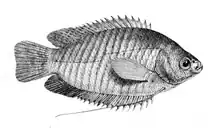| Trichogaster fasciata | |
|---|---|
 | |
| Illustration by Francis Day | |
| Scientific classification | |
| Domain: | Eukaryota |
| Kingdom: | Animalia |
| Phylum: | Chordata |
| Class: | Actinopterygii |
| Order: | Anabantiformes |
| Family: | Osphronemidae |
| Genus: | Trichogaster |
| Species: | T. fasciata |
| Binomial name | |
| Trichogaster fasciata Bloch & J. G. Schneider, 1801 | |
| Synonyms[2] | |
| |
Trichogaster fasciata, the banded gourami or striped gourami or Colisa or Kholshe , is a tropical labyrinth perch found in some Asian countries like Bangladesh, Eastern India, Northeastern India, Nepal, Upper Myanmar, China and Pakistan.[3]
It is also called giant gourami and for this reason it is often being confused with the Osphronemus goramy which has the same common name.[4]
Characteristics
Trichogaster fasciata is an air-breathing fish, so that the aerial respiration is performed with the help of a pair of supra-branchial chambers, each containing a complicated labyrinthine organ. Body is elongated and compressed. Mouth is small and slightly protrusible. Preorbital serrate is found in young fish. Body color is greenish with oblique orange or bluish bars descending downwards and backwards from the back to the anal fin.[5] It is benthopelagic and prefers weedy environments[6] such as estuaries, ponds, large rivers, ditches, lakes[1][7] and rice fields.[1] The species has drawn attention for its scrumptious taste, contribution to nutrition and its ornamental value as an aquarium fish.[8] It is somewhat shy but quite hardy, and easily adapts to life in community aquarium. It is also easy to breed in captivity. Banded gourami is being exported to Germany, Hong Kong, Japan, Malaysia, Republic of Korea, Singapore, Taiwan, Thailand and USA due to their distinctive color.[9] In the past, the species was readily available in freshwater pools, ponds, ditches, marshes, rivers, lakes with vegetation, but the natural resources of this fish are declining fast due to various anthropogenic stressors.[10]
Feeding habit
The mouth of this species is bordered by thick lips, the upper being protrudable and more pronounced in the male. Small and feeble teeth are present in the mouth and buccal cavity. The intestine is long and coiled.[5] The fish is omnivorous in nature, so they can feed on live, frozen and flake feeds.[8]
Sexual dimorphism
Males are much more colourful than females, and develop pointed dorsal and anal fins when they are mature.[11]
Reproduction
The total life span of this species is approximately 4 years. Banded gourami has three distinctive life stages: pre-spawning (January–March), spawning (April–August) and post-spawning (September–December). They become sexually mature at 1 year of age with the total length of male and female reached approximately at 10 cm and 6–8 cm, respectively. Generally males are slightly larger in size than their females.[5] Male and female broods are distinguished by examining the gonads and based on the external morphological features: the upper lip of the male is more pronounced and the dorsal ventral fins are more pointed at the posterior end than those of the female. Like other Anabantoids, this species is a bubble nest builder and the fertilization is external.[12]
Relationship with humans
Before being introduced into the aquarium trade, the dwarf, along with the snakeskin gourami was and still is a popular food fish in its native range.[13] In Bangladesh it is known as “Kholisha” and “”Khosti” in India and “Kungee” in Punjab as well as different linguistic variants within its range.
Taxonomy
Trichogaster fasciata was formally described in 1801 by Marcus Elieser Bloch and Johann Gottlob Schneider with the type locality given as Tranquebar, a Danish trading post in India.[14] It is the type species of the genus Trichogaster.[15]
References
- 1 2 3 Vishwanath, W. (2010). "Trichogaster fasciata". IUCN Red List of Threatened Species. 2010: e.T166485A6219165. doi:10.2305/IUCN.UK.2010-4.RLTS.T166485A6219165.en. Retrieved 19 November 2021.
- ↑ Froese, Rainer; Pauly, Daniel (eds.) (2019). "Tricjogaster fasciata" in FishBase. August 2019 version.
- ↑ Sumon, K.A. (2017). "Acute toxicity of chlorpyrifos to embryo and larvae of banded gourami Trichogaster fasciata". Journal of Environmental Science and Health, Part B. 52 (2): 92–98. Bibcode:2017JESHB..52...92S. doi:10.1080/03601234.2016.1239979. PMID 28099091. S2CID 11507639.
- ↑ Alderton, David (2019). Encyclopedia of Aquarium and Pond Fish. UK: Dorling Kindersley Limited. p. 111. ISBN 978-0-2413-6424-6.
- 1 2 3 Mitra, K. (2007). "Biology and fishery of banded gourami, Colisa fasciata (Bloch and Schneider 1801) in a floodplain wetland of Ganga river basin". Asian Fisheries Science. 20 (4): 409–423. doi:10.33997/j.afs.2007.20.4.007.
- ↑ Menon, A.G.K. (1999), Check list - fresh water fishes of India, Zoological Survey of India, p. 366
- ↑ Talwar, P.K.; Jhingran, A.G. (1991), Inland fishes of India and adjacent countries, Rotterdam: A.A. Balkema
- 1 2 Goodwin, D. (2003). The practical aquarium fish handbook. New York: Sterling Publishing Company.
- ↑ Sugunan, V.V. (2002). Ornamental fishes of West Bengal. Kolkata, India: Classic Printers.
- ↑ Hossen, M.S. (2014). "Effects of polyunsaturated fatty acids (PUFAs) on gonadal maturation and spawning of striped gourami, Colisa fasciatus". International Aquatic Research. 6 (2): 65. doi:10.1007/s40071-014-0065-7.
- ↑ Dehadrai, P.V. (1973). "Sexual dimorphism in certain air breathing teleosts". Journal of the Inland Fisheries Society of India. 5: 1–77.
- ↑ Swarup, K. (1972). "Sexual dimorphism in the Giant Gourami, Colisa fasciata (Anabantidae)". Proceedings of the National Academy of Sciences. 42: 93–94.
- ↑ "food". agrilife24. Retrieved 16 January 2022.
- ↑ Eschmeyer, William N.; Fricke, Ron & van der Laan, Richard (eds.). "Trichogaster fasciata". Catalog of Fishes. California Academy of Sciences. Retrieved 15 December 2019.
- ↑ Eschmeyer, William N.; Fricke, Ron & van der Laan, Richard (eds.). "Trichogaster". Catalog of Fishes. California Academy of Sciences. Retrieved 15 December 2019.
